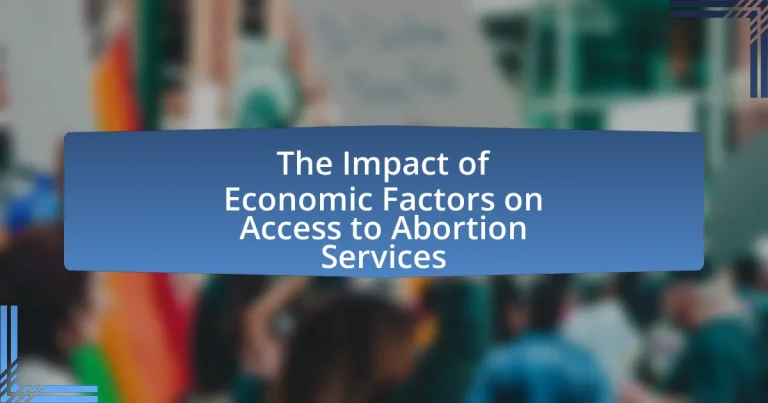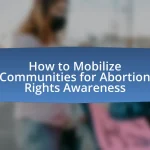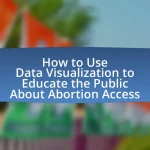The article examines the economic factors that significantly influence access to abortion services, highlighting how income levels, healthcare costs, and insurance coverage create barriers for individuals seeking these services. It discusses the impact of poverty on access, the role of disposable income in decision-making, and the implications of state funding and insurance policies. Additionally, the article addresses the consequences of limited access, including health risks and economic instability, particularly for marginalized communities. Strategies to improve access, such as policy changes, public funding initiatives, and community outreach programs, are also explored, emphasizing the importance of reducing stigma and enhancing awareness around abortion services.
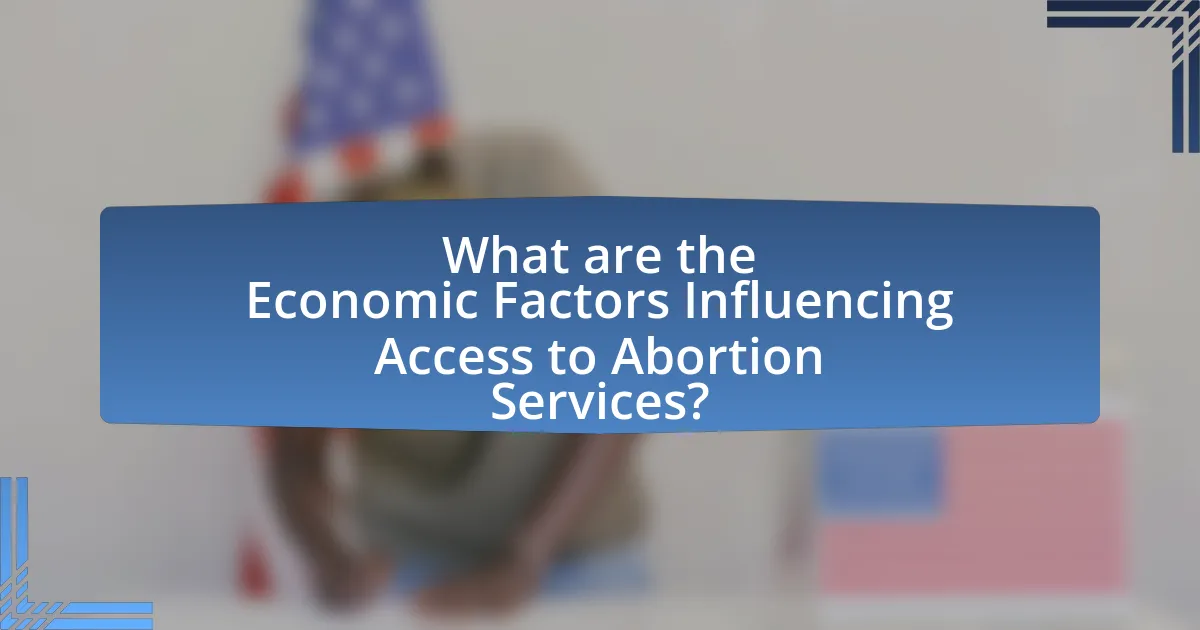
What are the Economic Factors Influencing Access to Abortion Services?
Economic factors influencing access to abortion services include income levels, healthcare costs, and insurance coverage. Individuals with lower income may face significant barriers due to the high out-of-pocket expenses associated with abortion procedures, which can range from hundreds to thousands of dollars depending on the state and gestational age. Additionally, lack of insurance coverage for abortion services exacerbates these financial barriers; for instance, many states have restrictions that prevent Medicaid from covering abortion costs, leaving low-income individuals without financial support. Furthermore, economic disparities can lead to unequal access to clinics, as facilities may be concentrated in wealthier areas, making it difficult for economically disadvantaged individuals to obtain services. These factors collectively create a landscape where economic status directly impacts the ability to access safe and legal abortion services.
How do income levels affect access to abortion services?
Income levels significantly affect access to abortion services, as individuals with lower incomes often face financial barriers that limit their ability to obtain these services. Research indicates that low-income individuals may struggle to afford the costs associated with abortion, including the procedure itself, travel expenses, and related healthcare costs. For instance, a study published in the American Journal of Public Health found that women with incomes below the federal poverty level were more likely to report difficulties in accessing abortion services compared to those with higher incomes. Additionally, state-level restrictions and lack of insurance coverage for abortion services disproportionately impact low-income populations, further exacerbating disparities in access.
What role does poverty play in limiting access to abortion services?
Poverty significantly limits access to abortion services by creating financial barriers that prevent individuals from affording the procedure and associated costs. Individuals living in poverty often lack the necessary funds for the procedure itself, which can range from hundreds to thousands of dollars, depending on the location and gestational age. Additionally, they may face challenges in covering transportation costs to clinics, which are often located far from low-income neighborhoods. According to a study published in the American Journal of Public Health, women with lower incomes are more likely to experience delays in obtaining abortions, leading to increased costs and potential health risks. Furthermore, restrictive state laws and lack of insurance coverage for abortion services disproportionately affect low-income individuals, exacerbating the barriers they face.
How does disposable income influence decision-making regarding abortion?
Disposable income significantly influences decision-making regarding abortion by affecting individuals’ ability to afford the procedure and related costs. Higher disposable income allows individuals to access abortion services more easily, as they can cover expenses such as medical fees, travel, and time off work. Conversely, lower disposable income may lead to delays in seeking an abortion or result in individuals opting for unsafe procedures due to financial constraints. Research indicates that economic factors, including disposable income, are critical in shaping reproductive choices, as evidenced by a study published in the American Journal of Public Health, which found that women with lower incomes are more likely to face barriers to accessing abortion services.
What impact do healthcare costs have on access to abortion services?
Healthcare costs significantly limit access to abortion services. High expenses associated with abortion procedures, including consultation fees, medical tests, and follow-up care, create financial barriers for individuals seeking these services. According to a study published in the American Journal of Public Health, nearly 40% of women reported that the cost of an abortion was a significant factor in their decision-making process, often leading to delays or the inability to obtain the procedure altogether. Additionally, states with restrictive abortion laws often impose additional costs, such as mandatory waiting periods and counseling, further exacerbating the financial burden. This economic strain disproportionately affects low-income individuals, who may lack insurance coverage for abortion services, thereby limiting their access and options.
How do insurance coverage and out-of-pocket expenses affect access?
Insurance coverage and out-of-pocket expenses significantly affect access to abortion services by determining the financial burden on individuals seeking care. When insurance plans include comprehensive coverage for abortion services, individuals face lower out-of-pocket costs, which increases their likelihood of accessing these services. Conversely, high out-of-pocket expenses, such as deductibles and co-pays, can deter individuals from seeking necessary care, particularly among low-income populations. A study published in the American Journal of Public Health found that states with Medicaid coverage for abortion services had higher rates of abortion access compared to states without such coverage, highlighting the direct correlation between insurance availability and access to care.
What are the implications of state funding on abortion services availability?
State funding significantly impacts the availability of abortion services by directly influencing the resources allocated to these services. When states provide funding for abortion services, it typically leads to increased access, as clinics can operate more effectively and offer services to a broader population. For instance, research from the Guttmacher Institute indicates that states that allocate public funds for abortion services see higher rates of service provision and lower barriers for low-income individuals seeking care. Conversely, states that restrict funding often experience clinic closures and reduced service availability, which disproportionately affects marginalized communities. This dynamic illustrates that state funding is a critical determinant of access to abortion services.
How do economic disparities affect different demographics’ access to abortion services?
Economic disparities significantly limit access to abortion services for various demographics, particularly affecting low-income individuals and marginalized communities. Research indicates that individuals from lower socioeconomic backgrounds often face financial barriers, such as the inability to afford the cost of the procedure, travel expenses to clinics, and associated healthcare costs. For instance, a study by the Guttmacher Institute found that nearly 75% of women who seek abortions are low-income, highlighting the correlation between economic status and access to reproductive healthcare. Additionally, systemic issues such as lack of insurance coverage for abortion services further exacerbate these disparities, disproportionately impacting women of color and those living in rural areas, where clinics may be scarce.
What are the barriers faced by marginalized communities in accessing abortion services?
Marginalized communities face multiple barriers in accessing abortion services, primarily due to economic factors, systemic inequalities, and social stigma. Economic barriers include lack of financial resources to cover the costs of the procedure, travel expenses, and associated healthcare costs, which disproportionately affect low-income individuals. Systemic inequalities manifest through limited availability of clinics in underserved areas, often referred to as “abortion deserts,” where access to services is severely restricted. Additionally, social stigma surrounding abortion can deter individuals from seeking necessary care, further complicating access. According to the Guttmacher Institute, 75% of women who seek abortions are low-income, highlighting the significant impact of economic factors on access to these services.
How does geographic location influence access to abortion services?
Geographic location significantly influences access to abortion services by determining the availability of clinics, state laws, and socioeconomic factors. In urban areas, there is typically a higher concentration of healthcare facilities, including abortion providers, compared to rural regions where such services may be scarce or non-existent. For instance, a study by the Guttmacher Institute found that 90% of U.S. counties do not have an abortion provider, with rural counties being disproportionately affected. Additionally, state laws vary widely; some states impose strict regulations that can limit access, while others have more supportive policies. This geographic disparity creates significant barriers for individuals seeking abortion services, particularly in areas with restrictive laws and fewer healthcare resources.
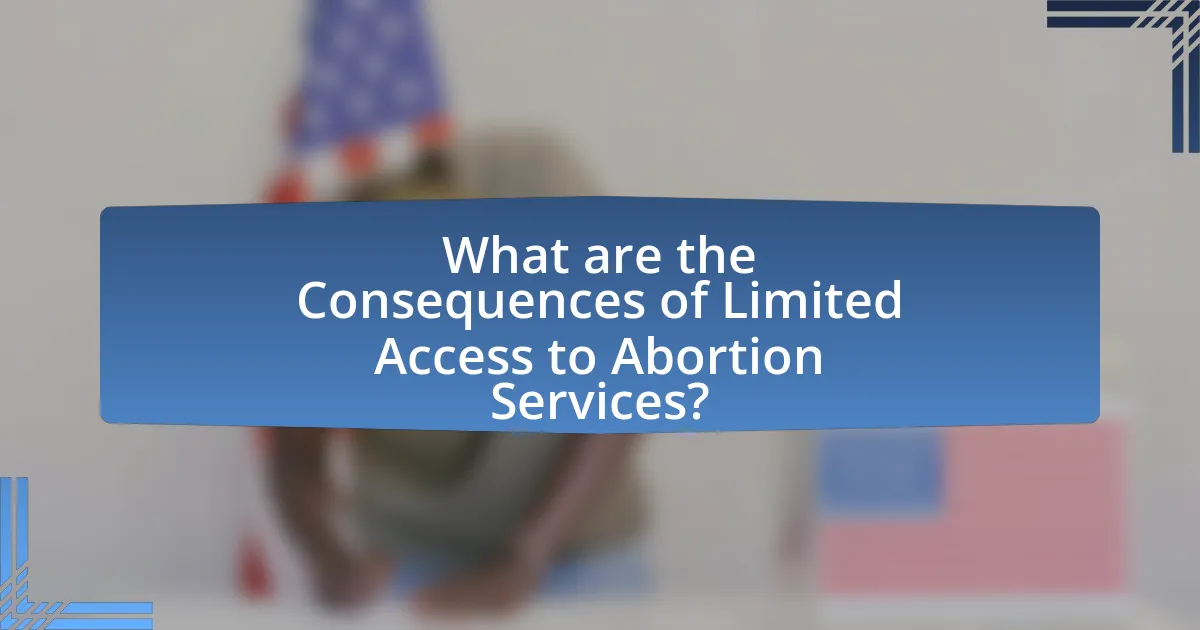
What are the Consequences of Limited Access to Abortion Services?
Limited access to abortion services leads to increased health risks for individuals who may resort to unsafe procedures. Research indicates that when legal abortion services are restricted, the incidence of unsafe abortions rises significantly, contributing to maternal morbidity and mortality. For instance, the World Health Organization reports that unsafe abortions account for approximately 13% of maternal deaths globally, highlighting the severe health consequences of limited access. Additionally, restricted access can result in economic burdens, as individuals may face higher healthcare costs due to complications arising from unsafe procedures. This situation disproportionately affects low-income populations, exacerbating existing inequalities in healthcare access and outcomes.
How does restricted access to abortion services impact women’s health?
Restricted access to abortion services negatively impacts women’s health by increasing the likelihood of unsafe procedures and adverse health outcomes. When women cannot obtain legal and safe abortions, they may resort to unregulated methods, leading to complications such as infections, hemorrhaging, and even death. According to the World Health Organization, unsafe abortions contribute to approximately 47,000 maternal deaths annually worldwide. Furthermore, restricted access can exacerbate mental health issues, as women may experience increased anxiety, depression, and stress related to unwanted pregnancies. Studies indicate that women denied abortions are more likely to experience long-term psychological distress compared to those who receive the care they seek.
What are the physical health risks associated with limited access?
Limited access to abortion services poses significant physical health risks, including increased rates of complications from unsafe procedures, higher instances of maternal mortality, and adverse mental health outcomes. Research indicates that when individuals cannot access safe abortion services, they may resort to unsafe methods, leading to severe complications such as infections, hemorrhage, and injury to reproductive organs. According to the World Health Organization, unsafe abortions contribute to approximately 47,000 maternal deaths annually, highlighting the critical link between access and health outcomes. Furthermore, limited access can exacerbate existing health conditions and lead to prolonged psychological distress, further compromising overall health.
How does mental health get affected by restricted abortion access?
Restricted abortion access negatively affects mental health by increasing anxiety, depression, and feelings of helplessness among individuals facing unwanted pregnancies. Research indicates that individuals denied abortions are more likely to experience mental health issues compared to those who can access the procedure. A study published in the American Journal of Psychiatry found that women who were denied an abortion were three times more likely to experience anxiety and depression one week after the decision compared to those who received the abortion. This correlation highlights the psychological distress associated with restricted access to abortion services, emphasizing the importance of reproductive rights in maintaining mental well-being.
What are the social implications of limited access to abortion services?
Limited access to abortion services leads to significant social implications, including increased economic hardship for individuals and families. When abortion services are restricted, individuals may face unplanned pregnancies that can strain financial resources, particularly among low-income populations. Research indicates that women who are denied abortions are more likely to experience economic instability, with a study from the Turnaway Study showing that 74% of women who were denied an abortion reported financial difficulties two years later. Additionally, limited access can exacerbate existing inequalities, as marginalized groups often have fewer resources to navigate the barriers to obtaining care, leading to disparities in health outcomes and social mobility.
How does access to abortion services influence women’s economic stability?
Access to abortion services significantly enhances women’s economic stability by allowing them to make informed decisions about their reproductive health and family planning. When women can access abortion services, they are better able to pursue education and career opportunities without the interruption of unplanned pregnancies. Research indicates that women who have access to abortion are more likely to complete their education and participate in the workforce, leading to higher earning potential. For instance, a study published in the American Journal of Public Health found that women who were denied abortions were more likely to experience economic hardship and rely on public assistance compared to those who had access to the procedure. This evidence underscores the critical link between reproductive autonomy and economic empowerment for women.
What are the broader societal impacts of restricted abortion access?
Restricted abortion access leads to significant societal impacts, including increased maternal mortality rates and economic instability for families. Studies indicate that regions with limited access to abortion services experience higher rates of unsafe abortions, which contribute to maternal deaths; for instance, the World Health Organization reported that unsafe abortions account for approximately 13% of maternal deaths globally. Furthermore, restricted access disproportionately affects low-income individuals, exacerbating economic disparities as families face increased financial burdens from unplanned pregnancies. This economic strain can lead to long-term consequences, such as reduced educational and employment opportunities for women, ultimately affecting overall societal productivity and health outcomes.
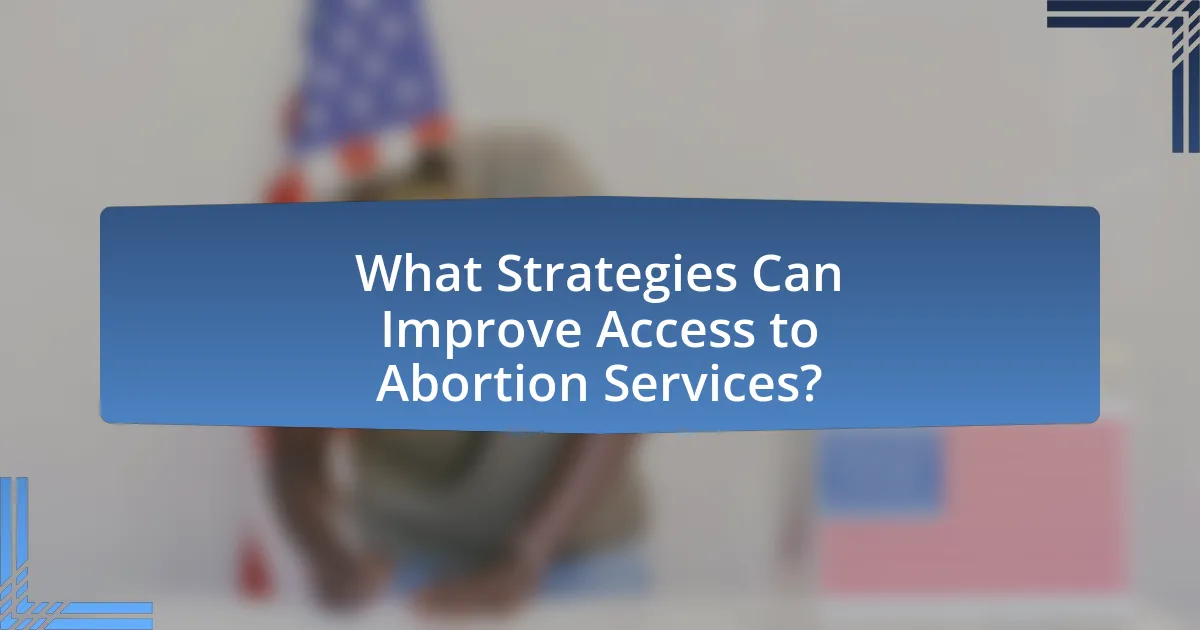
What Strategies Can Improve Access to Abortion Services?
Improving access to abortion services can be achieved through strategies such as increasing funding for reproductive health services, expanding telehealth options, and implementing policies that reduce financial barriers. Increased funding can enhance the availability of clinics and services, as evidenced by the Guttmacher Institute’s report indicating that states with higher funding for reproductive health services have better access to abortion. Expanding telehealth options allows patients to consult with healthcare providers remotely, which has been shown to increase access, particularly in rural areas. Additionally, policies that eliminate co-pays and provide insurance coverage for abortion services can significantly reduce financial barriers, as demonstrated by studies showing that when costs are covered, more individuals seek and obtain abortions.
How can policy changes enhance access to abortion services?
Policy changes can enhance access to abortion services by removing legal barriers, increasing funding for clinics, and expanding insurance coverage. For instance, states that have enacted laws to protect abortion rights and ensure funding for reproductive health services have seen improved access for women. According to the Guttmacher Institute, states that provide Medicaid coverage for abortion services have higher rates of access, as financial constraints are a significant barrier for many individuals seeking these services. Additionally, policies that streamline the process for obtaining abortions, such as reducing waiting periods and allowing telehealth consultations, further facilitate access.
What legislative measures can support better access to abortion services?
Legislative measures that can support better access to abortion services include the repeal of restrictive laws, the implementation of public funding for abortion services, and the establishment of comprehensive sex education programs. Repealing laws such as mandatory waiting periods and parental consent requirements can reduce barriers to access. Public funding, as seen in states like California, ensures that low-income individuals can obtain necessary services without financial strain. Comprehensive sex education programs, which have been shown to reduce unintended pregnancies, can also lead to increased awareness and access to reproductive health services. These measures collectively enhance access to abortion services and address economic factors that may limit availability.
How can public funding initiatives improve access for low-income individuals?
Public funding initiatives can improve access for low-income individuals by providing financial resources that cover the costs of essential services, including healthcare and abortion. These initiatives can reduce the economic barriers that low-income individuals face, enabling them to obtain necessary medical care without the burden of high out-of-pocket expenses. For instance, studies have shown that states with Medicaid expansion have seen increased access to reproductive health services, including abortion, for low-income women, as they are more likely to receive coverage for these services. This financial support is crucial in ensuring that low-income individuals can make informed choices about their reproductive health without being constrained by their economic situation.
What role do advocacy groups play in improving access to abortion services?
Advocacy groups play a crucial role in improving access to abortion services by mobilizing public support, influencing policy changes, and providing resources to individuals seeking care. These organizations often engage in campaigns to raise awareness about reproductive rights and the importance of accessible abortion services, which can lead to legislative reforms that expand access. For instance, the Guttmacher Institute reports that states with strong advocacy efforts tend to have fewer restrictions on abortion services, demonstrating a direct correlation between advocacy and access. Additionally, advocacy groups often provide financial assistance, educational resources, and referrals to clinics, further facilitating access for those in need.
How can community outreach programs increase awareness and access?
Community outreach programs can increase awareness and access to abortion services by providing targeted education and resources to underserved populations. These programs often conduct workshops, distribute informational materials, and collaborate with local organizations to reach individuals who may lack knowledge about available services. For instance, a study by the Guttmacher Institute found that community-based initiatives significantly improved awareness of reproductive health services among low-income women, leading to increased utilization of those services. By addressing barriers such as stigma and misinformation, outreach programs effectively enhance both awareness and access to essential abortion services.
What strategies can be employed to reduce stigma around abortion services?
To reduce stigma around abortion services, comprehensive education and awareness campaigns can be employed. These campaigns should focus on providing accurate information about abortion, including its safety, legality, and the reasons individuals may seek these services. Research indicates that stigma often arises from misinformation; for instance, a study published in the American Journal of Public Health found that increased knowledge about abortion correlates with reduced stigma. Additionally, engaging healthcare professionals in training programs that emphasize empathy and non-judgmental care can further diminish stigma. By fostering open dialogues within communities and promoting supportive narratives, the perception of abortion services can shift towards understanding and acceptance.
What practical steps can individuals take to navigate access to abortion services?
Individuals can navigate access to abortion services by researching local laws and regulations regarding abortion in their area. Understanding the legal framework is crucial, as access can vary significantly by state or country. Additionally, individuals should identify and contact local healthcare providers or clinics that offer abortion services, as they can provide information on available options, costs, and any financial assistance programs. Utilizing resources such as the National Abortion Federation or Planned Parenthood can also help individuals find clinics and understand their rights. Furthermore, individuals may consider seeking support from organizations that advocate for reproductive rights, which can offer guidance and assistance in navigating the process.
